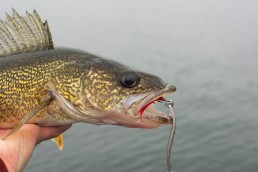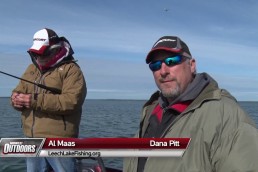Walleye Catching Tempo Trifecta
SHARE THIS POST
Retrieve fundamentals for sinking walleye baits
Sinking baits like jigs, swimbaits and blade baits are reliable walleye catchers and work well for jigging along bottom where fish lurk. Retrieve speed is an important presentation consideration, and our focus here. At certain times, walleyes are choosy and only strike a bait moving within a specific speed range. In light of this, here are some tips for fishing sinking lures on fast, moderate and slow retrieves.
Rippin’ and reelin’
Naturally, fast retrieves work great for covering water and searching flats, shorelines, large structures, and river ledges. Aggressive snaps teamed with reeling also work well for triggering strikes from active fish willing to chase. Here’s a basic recipe that works for several sinking lures, but I really like it for casting spoons, like the Luhr-Jensen Krocodile, Strike King Sexy Spoon, and Blue Fox Moresilda.
A quick, 1- to 2-foot upward snap raises the bait. Next, reel to pick up some slack line while lowering the rod, but keep the line semi-slack. This gives the bait room to dance. It also helps feel a strike or see the line jump on the drop. Snap the bait again once it touches bottom.
A variation on this ripping retrieve is adding a few reel turns after the snap. This swims the bait a short distance after its initial scurry off the floor.
Also good is using two short rod snaps instead of one. This results in two distinct hopping motions. The dual darting action replicates the erratic action of a baitfish trying to escape. This combination works well for a jig rigged with a fluke or twister tail grub.
Mid-range maneuvers
While fast lures can be fantastic, some days walleye prefer mid-range speeds. Achieving this is as straightforward as slowing down the retrieves outlined above. For instance, instead of a fast snap, try a steady lift combined with an average reel speed.
Another reason moderate speeds catch walleye is less about fish preferences and more about getting the best action out of some styles of lures. Certain lipless crankbaits, swimbaits, and blade baits produce their best action and emit more alluring vibrations at a moderate pace. Going too fast overworks the lure and makes it less appealing.
Observing a lure’s action at boat side and feeling a bait’s vibration in the rod helps determine the right speed for the best action. Getting tempo right can be trickier than many anglers appreciate.
Hints from Haataja
“Of all the techniques I teach, blade bait fishing takes more time and persistence to have success,” said Eric Haataja, operator of Wisconsin’s Big Fish Guide Service.
With over 200 days on the water a year, Haataja knows what he’s talking about. I met him at a writer’s event last year. Being blade bait fanatics, we’ve had a few long chats on the subject. What Haataja has observed is that many of his clients struggle to catch walleyes on a blade bait because they overwork it, pulling it too fast or lifting it too far off bottom.
“It’s all about small rod tip pops,” said Haataja. “A short snap and always keeping a taught line [when the bait sinks]. Keep the rod tip in the hook set position so when the fish taps the bait you can quickly set the hook.”
Haataja’s technique is a good example of a moderate retrieve. He predominantly fishes blades in cold water in spring and fall on 6- to 8-pound braid with a 10-pound fluorocarbon leader. A medium-light rod cushiona the fight and help keep small hooks on 1/4-ounce blades from tearing out. The softer rod also absorbs some of the jigging action, so although we’re talking a 4- to 6-inch snap, the rod’s influence makes the blade’s speed a mid-range pace. Search Haataja on YouTube and you can see his blade bait jigging retrieves as well as view other interesting angling topics.
Looking for a place to put our tips to the test? Read up on the Rainy River and get on the hunt for big walleyes on Lake Erie.
Are you enjoying this post?
You can be among the first to get the latest info on where to go, what to use and how to use it!
Puttering finesse
Slow retrieves should also be in a walleye angler’s repertoire. Unhurried and precise lure presentations are the bread-and-butter for finessing bites from neutral or inactive walleye. Slow and methodical casting methods also work when walleye are tight to structure or concentrated in specific spots.
A slow reeling retrieve is an easy way to swim a bait along bottom. Stop reeling, and the bait sinks. This works great with jig-and-grub combinations and swimbaits. It’s deadly too for live-bait tipped jigs.
Another approach is performing the fast and moderate retrieves noted above, but doing them in slow-motion, so to speak. Experimentation will reveal how slowly different lures can perform while still maintaining good action.
Erratic and irregular
When experimenting with jigging retrieve speeds and sinking baits, anglers should vary lure tempo to create an erratic action. Many times it’s these irregular moves that trigger hits. Use lifts, pops, snaps, twitches, and jerks to change how high or fast a lure jumps off bottom, and how quick or far it swims.
Adding variety to a retrieve can trip a wire in a walleye’s brain and cause it to lash out. A walleye might see the sudden change as a baitfish trying to evade another predator, or perceive the jerky swimming movement to be that of an injured minnow. Remember, erratic doesn’t necessarily mean fast and flamboyant. Even with a slow retrieve, the odd rod flick or sudden stutter-step can provoke a strike.
What goes up…
Lure weight influences retrieve speeds. Some days a bait that crashes to bottom outperforms one that lazily drops. Other times the opposite holds true.
Recently, I’ve had some great outings using 3/16-ounce jig heads for fishing a 4-inch minnow or 5-inch jerk shads for walleye in shallow and mid-depth areas. Experimenting with other boat partners, the slower sink rate of a 3/16-ounce jig out-fished 1/4- and 3/8-ounce combinations fished side by side on 8-pound fluorocarbon on several trips.
Anglers also need to be aware that jig weight impacts the action of plastics. For instance, certain swimbaits don’t wiggle as well on a 3/16-ounce jig head as they do on a 1/4- or 3/8-ounce version. Every bait is different. Experiment to find the best action.
Line type and diameter also impacts sink rate. Ultra-thin, 8-pound braid provides much less water resistance than a similar strength monofilament or fluorocarbon. Be mindful of line properties when experimenting with jigging retrieve speeds.
Paying attention to jigging speed and tempo details will help you catch more fish. Experiment with fast, moderate, and slow retrieves. Then fine-tune technique once you find a productive tempo.
Tim Allard hails from Ottawa, Ontario, Canada. He’s a full-time outdoor journalist and author and photographer of the multi-award winning book, “Ice Fishing – The Ultimate Guide” (2010). For more information visit timallard.ca.
Slow, fast, in between, erratic or steady, experimenting with retrieves will put more Canadian fish on the hook for you.
MWO
SHARE THIS POST
Did you enjoy this post?
You can be among the first to get the latest info on where to go, what to use and how to use it!
Tim Allard
Tim Allard is a full-time outdoor journalist and author and photographer of the multi-award-winning book, Ice Fishing––The Ultimate Guide. Follow him on Instagram @timallardtips.



